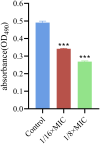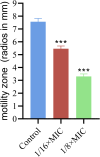Antibiofilm effects of bacteriocin PCM7-4 on Listeria monocytogenes
- PMID: 40471979
- PMCID: PMC12140390
- DOI: 10.1371/journal.pone.0325109
Antibiofilm effects of bacteriocin PCM7-4 on Listeria monocytogenes
Abstract
Listeria monocytogenes is a significant zoonotic pathogen capable of forming biofilms on food and other materials, representing a considerable risk to human health and animal husbandry. The use of bacteriocins as potential new antibacterial and antibiofilm reagents has attracted considerable interest. This study aimed to determine the inhibitory effects of bacteriocin PCM7-4 on L. monocytogenes biofilm formation. In this study, bacteriocin PCM7-4 of SICs (1/16 × MIC, 1/8 × MIC) significantly inhibited the formation of L. monocytogenes biofilm. Bacteriocin PCM7-4 of SICs significantly reduced the production of bacterial extracellular polysaccharides, and could decrease the bacterial motility, meanwhile, PCM7-4 significantly reduced the number and viability of bacteria within the biofilm. RT-qPCR results showed that bacteriocin PCM7-4 significantly reduced the expression of flagella, community sensing and virulence factor genes associated with biofilm formation. The results demonstrated the considerable potential of bacteriocin PCM7-4 as a therapeutic agent for the prevention and treatment of L. monocytogenes biofilms.
Copyright: © 2025 Ma et al. This is an open access article distributed under the terms of the Creative Commons Attribution License, which permits unrestricted use, distribution, and reproduction in any medium, provided the original author and source are credited.
Conflict of interest statement
The authors have declared that no competing interests exist.
Figures








Similar articles
-
Identification and characterization of a novel bacteriocin PCM7-4 and its antimicrobial activity against Listeria monocytogenes.Microbiol Res. 2025 Jan;290:127980. doi: 10.1016/j.micres.2024.127980. Epub 2024 Nov 22. Microbiol Res. 2025. PMID: 39581173
-
Effects of Sub-Minimum Inhibitory Concentrations of Bacteriocin BM173 on Listeria Monocytogenes Biofilm Formation.Probiotics Antimicrob Proteins. 2024 Dec;16(6):2305-2315. doi: 10.1007/s12602-023-10192-1. Epub 2023 Nov 20. Probiotics Antimicrob Proteins. 2024. PMID: 37982962
-
Antibiofilm Effects of Bacteriocin BMP32r on Listeria monocytogenes.Probiotics Antimicrob Proteins. 2022 Dec;14(6):1067-1076. doi: 10.1007/s12602-021-09863-8. Epub 2021 Oct 28. Probiotics Antimicrob Proteins. 2022. PMID: 34709598
-
Targeting motility of Listeria monocytogenes: Alternative strategies to control foodborne illness.Microb Pathog. 2025 May;202:107427. doi: 10.1016/j.micpath.2025.107427. Epub 2025 Feb 26. Microb Pathog. 2025. PMID: 40021026 Review.
-
Molecular biology of surface colonization by Listeria monocytogenes: an additional facet of an opportunistic Gram-positive foodborne pathogen.Environ Microbiol. 2011 Apr;13(4):835-50. doi: 10.1111/j.1462-2920.2010.02378.x. Epub 2010 Nov 18. Environ Microbiol. 2011. PMID: 21087384 Review.
References
-
- Reis J, Teixeira L, Cunha-Neto A, Castro V, Figueiredo E. Listeria monocytogenes in beef: a hidden risk. Res Microbiol. 2024. p. 104215. - PubMed
-
- Buchanan RL, Gorris LGM, Hayman MM, Jackson TC, Whiting RC. A review of Listeria monocytogenes : an update on outbreaks, virulence, dose-response, ecology, and risk assessments. Food Control. 2017;75:1–13. doi: 10.1016/j.foodcont.2016.12.016 - DOI
MeSH terms
Substances
LinkOut - more resources
Full Text Sources
Medical

